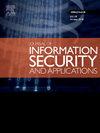Detection of denial-of-service attack using a novel hybrid learning technique
IF 3.8
2区 计算机科学
Q2 COMPUTER SCIENCE, INFORMATION SYSTEMS
Journal of Information Security and Applications
Pub Date : 2025-05-08
DOI:10.1016/j.jisa.2025.104081
引用次数: 0
Abstract
Physical Layer Security (PLS) in wireless networks is becoming crucial with advancements in technologies like Beyond-5G (B5G) and 6G. To address growing threats such as Denial of Service (DoS) attacks, PLS uses Machine Learning (ML) techniques to detect and counter these threats effectively. PLS secures wireless communication systems, by utilizing the physical properties of the communication medium such as signal metrics, channel characteristics and noise patterns. In this paper, a novel approach to classify attack and non-attack scenarios using Long Short-Term Memory-Fully Connected network (LSTM-FCNet) for feature extraction and Gradient Boost (GB) algorithm for classification has been proposed. The DoS attack datasets are generated in the form of jamming, where both attack and non-attack case wireless channel behaviour are captured using Channel State Information (CSI) under various Signal to Noise Ratio (SNR) conditions. The proposed hybrid learning technique plays a crucial role to extract features, in order to capture temporal dependencies in the data, which is significant for identifying delicate patterns. These features are then classified using the GB algorithm to accurately distinguish between attack and non-attack scenarios. The simulated results show that the attack detection accuracy has been achieved up to a maximum of 98.25 % for different SNR values, with precision, recall, and F1-score of all achieving 98 %. The Receiver Operating Characteristic (ROC) curve with a value of 0.99 indicates that the classifier has achieved a high True Positive Rate (TPR). The results ensure that the classifier works at peak accuracy for the developed attack detection model, effectively handling the generated DoS attack dataset.
基于混合学习技术的拒绝服务攻击检测
随着超5g (B5G)和6G等技术的进步,无线网络中的物理层安全(PLS)变得至关重要。为了应对不断增长的威胁,如拒绝服务(DoS)攻击,PLS使用机器学习(ML)技术来有效地检测和应对这些威胁。PLS通过利用通信介质的物理特性(如信号度量、信道特性和噪声模式)来保护无线通信系统。本文提出了一种利用长短期记忆-全连接网络(LSTM-FCNet)进行特征提取和梯度增强(GB)算法进行分类的攻击和非攻击场景分类新方法。DoS攻击数据集以干扰的形式生成,其中使用信道状态信息(CSI)在各种信噪比(SNR)条件下捕获攻击和非攻击情况下的无线信道行为。所提出的混合学习技术在提取特征方面起着至关重要的作用,以捕获数据中的时间依赖性,这对于识别微妙的模式具有重要意义。然后使用GB算法对这些特征进行分类,以准确区分攻击和非攻击场景。仿真结果表明,在不同信噪比下,攻击检测准确率最高可达98.25%,其中准确率、召回率和f1分数均达到98%。接受者工作特征(ROC)曲线值为0.99表明分类器达到了较高的真阳性率(TPR)。结果确保了分类器在所开发的攻击检测模型中工作在最高精度,有效地处理生成的DoS攻击数据集。
本文章由计算机程序翻译,如有差异,请以英文原文为准。
求助全文
约1分钟内获得全文
求助全文
来源期刊

Journal of Information Security and Applications
Computer Science-Computer Networks and Communications
CiteScore
10.90
自引率
5.40%
发文量
206
审稿时长
56 days
期刊介绍:
Journal of Information Security and Applications (JISA) focuses on the original research and practice-driven applications with relevance to information security and applications. JISA provides a common linkage between a vibrant scientific and research community and industry professionals by offering a clear view on modern problems and challenges in information security, as well as identifying promising scientific and "best-practice" solutions. JISA issues offer a balance between original research work and innovative industrial approaches by internationally renowned information security experts and researchers.
 求助内容:
求助内容: 应助结果提醒方式:
应助结果提醒方式:


